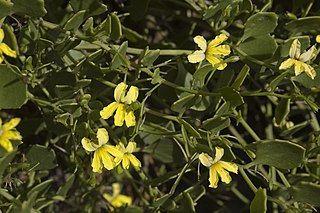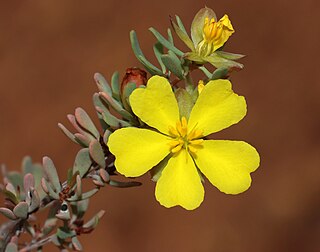
Goodenia hederacea, commonly known as forest goodenia or ivy goodenia, is a species of flowering plant that is endemic to eastern Australia. It is a prostrate to ascending, perennial herb with linear to elliptic or round leaves, and racemes of yellow flowers.

Cyanothamnus coerulescens, commonly known as blue boronia, is a plant in the citrus family, Rutaceae and is endemic to southern Australia. It is a small, spindly shrub with glandular stems, small, more or less cylindrical leaves and blue to pinkish mauve, four-petalled flowers. There are two subspecies endemic to Western Australia and a third that also occurs in three eastern states.

Goodenia arthrotricha is a species of flowering plant in the family Goodeniaceae and endemic to south-western Western Australia. It is an erect perennial, herb with linear to lance-shaped leaves with the narrower end towards the base, racemes of blue flowers with linear bracteoles at the base, and oval fruit.

Goodenia azurea, commonly known as blue goodenia, is a species of flowering plant in the family Goodeniaceae and is endemic to northern Australia. It is an erect, dense, spreading or sprawling, glaucous, perennial herb with egg-shaped leaves with the narrower end towards the base, racemes or thyrses of bluish-purple flowers with leaf-like bracts, and oval to cylindrical fruit.
Goodenia crenata is a species of flowering plant in the family Goodeniaceae and endemic to north-western Australia. It is a perennial, herb with oblong, elliptic or egg-shaped leaves in a rosette at the base of the plant, and leafy racemes of yellow flowers.
Goodenia drummondii is a species of flowering plant in the family Goodeniaceae and is endemic to the south-west of Western Australia. It is an erect shrub with linear to lance-shaped stem leaves, and spike-like thyrses of small white flowers with purplish spots.
Goodenia granitica is a species of flowering plant in the family Goodeniaceae and endemic to the south-west of Western Australia. It is an annual herb with spatula-shaped, sometimes lobed leaves, in a rosette at the base of the plant, and racemes of yellow flowers.
Goodenia halophila is a species of flowering plant in the family Goodeniaceae and is endemic to the northern Australia. It is a delicate annual herb with spatula-shaped, or lance-shaped leaves in a tuft at the base of erect or low-lying flowering stems, and cymes of yellow flowers.
Goodenia heatheriana is a species of flowering plant in the family Goodeniaceae and is endemic to Western Australia. It is a spreading annual herb with narrow egg-shaped leaves at the base of the plant and racemes of yellow flowers.
Goodenia jaurdiensis is a species of flowering plant in the family Goodeniaceae and endemic to the south-west of Western Australia. It is an annual herb with egg-shaped to lance-shaped leaves with the narrower end towards the base, the leaves at the base of the plant, and racemes of yellow to orange flowers.

Goodenia katabudjar is a species of flowering plant in the family Goodeniaceae and is endemic to a restricted area in the south-west of Western Australia. It is a hairy perennial sub-shrub with egg-shaped stem-leaves and blue, pink or white flowers.
Goodenia leptoclada, commonly known as thin-stemmed goodenia, is a species of flowering plant in the family Goodeniaceae and is endemic to the extreme south-west of Western Australia. It is an ascending perennial herb with lance-shaped to egg-shaped leaves with the narrower end towards the base and racemes of blue flowers.
Goodenia pedicellata is a species of flowering plant in the family Goodeniaceae and endemic to the Pilbara region of Western Australia. It is an perennial herb with a single stem, egg-shaped to trowel-shaped leaves with the narrower end towards the base, and racemes of yellow flowers on unusually long pedicels.
Goodenia psammophila is a species of flowering plant in the family Goodeniaceae and endemic to the Kimberley region of Western Australia. It is a prostrate or erect annual herb with narrow lance-shaped to egg-shaped leaves with the narrower end towards the base, and racemes of yellow flowers with brownish or whitish lobes.

Goodenia scapigera, commonly known as white goodenia, is a species of flowering plant in the family Goodeniaceae and is endemic to the south-west of Western Australia. It is an erect, perennial herb or shrub with linear to narrow egg-shaped leaves clustered near the ends of the stems, and thyrses of white flowers with purplish spots.

Goodenia sepalosa is a species of flowering plant in the family Goodeniaceae and is endemic to northern Australia. It is a prostrate to ascending herb with narrow oblong to lance-shaped leaves, the narrower end towards the base, and racemes of yellow flowers.

Goodenia varia, commonly known as sticky goodenia, is a species of flowering plant in the family Goodeniaceae and is endemic to southern Australia. It is an ascending to prostrate shrub with elliptic leaves, usually with toothed edges, and racemes or thyrses of yellow flowers.

Goodenia watsonii is a species of flowering plant in the family Goodeniaceae and is endemic to the south-west of Western Australia. It is a perennial herb with egg-shaped to elliptic leaves mostly at the base of the plant, and thyrses of white, cream-coloured or bluish flowers.

Hibbertia glomerata is a species of flowering plant in the family Dilleniaceae and is endemic to the south-west of Western Australia. It is a much-branched shrub with mostly oblong or egg-shaped to elliptic leaves and yellow flowers borne on the ends of short side shoots, with nine to twelve stamens, sometimes in groups of three, arranged around the three carpels.

Hibbertia humifusa is a species of flowering plant in the family Dilleniaceae and is endemic to central Victoria, Australia. It is a prostrate to low-lying shrub with linear to elliptic leaves, and bright yellow flowers with six to ten stamens arranged in a cluster on one side of the two carpels.










